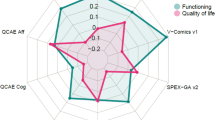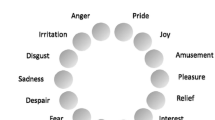Abstract
We present the Spanish validation of the “Movie for the Assessment of Social Cognition” instrument (MASC-SP). We recruited 22 adolescents and young adults with Asperger syndrome and 26 participants with typical development. The MASC-SP and three other social cognition instruments (Ekman Pictures of Facial Affect test, Reading the Mind in the Eyes Test, and Happé’s Strange Stories) were administered to both groups. Individuals with Asperger syndrome had significantly lower scores in all measures of social cognition. The MASC-SP showed strong correlations with all three measures and relative independence of general cognitive functions. Internal consistency was optimal (0.86) and the test–retest was good. The MASC-SP is an ecologically valid and useful tool for assessing social cognition in the Spanish population.


Similar content being viewed by others
Notes
The recruitment and evaluation phases of this project were completed in the period 2011-2012, before the publishing and adoption of DSM-5.
References
Adachi, T., Koeda, T., Hirabayashi, S., Maeoka, Y., Shiota, M., Wright, E. C., et al. (2004). The metaphor and sarcasm scenario test: A new instrument to help differentiate high functioning pervasive developmental disorder from attention deficit/hyperactivity disorder. Brain & Development., 26(5), 301–306.
Adler, N., Nadler, B., Eviatar, Z., & Shamay-Tsoory, S. G. (2010). The relationship between theory of mind and autobiographical memory in high-functioning autism and Asperger syndrome. Psychiatry Research, 178(1), 214–216.
APA. (2000). Diagnostic and Statistical Manual of Mental Disorders, fouth edition, text revised (4th ed.). Washinton, DC: American Psychiatric Association.
Baron-Cohen, S., Leslie, A. M., & Frith, U. (1985). Does the autistic child have a “theory of mind”? Cognition, 21(1), 37–46.
Baron-Cohen, S., Wheelwright, S., Hill, J., Raste, Y., & Plumb, I. (2001). The “Reading the Mind in the Eyes” Test revised version: A study with normal adults, and adults with Asperger syndrome or high-functioning autism. The Journal of Child Psychology and Psychiatry, 42(2), 241–251.
Bauminger, N., & Kasari, C. (1999). Brief report: Theory of mind in high-functioning children with autism. Journal of Autism and Developmental Disorders, 29(1), 81–86.
Beaumont, R., & Sofronoff, K. (2008). A new computerised advanced theory of mind measure for children with Asperger syndrome: The ATOMIC. Journal of Autism and Developmental Disorders, 38(2), 249–260. doi:10.1007/s10803-007-0384-2.
Boada, L., Lahera, G., Del Rey, A. & Parellada M. (in preparation). The Movie for the Assessment of Social Cognition: Differences and Similarities between young adults with Asperger syndrome and young adults with Schizophrenia.
Bowler, D. M. (1992). “Theory of mind” in Asperger’s syndrome. The Journal of Child Psychology and Psychiatry, 33(5), 877–893.
Corcoran, R. (2003). Inductive reasoning and the understanding of intention in schizophrenia. Cognitive Neuropsychiatry, 8(3), 223–235. doi:10.1080/13546800244000319.
Crane, L., Goddard, L., & Pring, L. (2011). Autobiographical memory in adults with Autism spectrum disorder: The role of depressed mood, rumination, working memory and theory of mind. Autism, doi: 10.1177/1362361311418690.
Crespi, B., & Badcock, C. (2008). Psychosis and autism as diametrical disorders of the social brain. Journal of Behavioral and Brain Science 31(3), 241–261; discussion 261–320, doi:10.1017/S0140525X08004214.
Dennet, D. C. (1987). Reprint of Intentional systems in cognitive ethology: The Panglossian paradigm defended. The Brain and Behavioral Sciences, 6, 343–390.
Dziobek, I., Fleck, S., Kalbe, E., Rogers, K., Hassenstab, J., Brand, M., et al. (2006). Introducing MASC: A movie for the assessment of social cognition. Journal of Autism and Developmental Disorders, 36(5), 623–636. doi:10.1007/s10803-006-0107-0.
Ekman, P., & Friesen, W. V. (1976). Pictures of facial affect. Palo Alto, CA: Consulting Psychologists Press.
Fisher, N., Happe, F., & Dunn, J. (2005). The relationship between vocabulary, grammar, and false belief task performance in children with autistic spectrum disorders and children with moderate learning difficulties. The Journal of Child Psychology and Psychiatry, 46(4), 409–419. doi:10.1111/j.1469-7610.2004.00371.x.
Fombonne, E. (2001). What is the prevalence of Asperger disorder? Journal of Autism and Developmental Disorders, 31(3), 363–364.
Fombonne, E., & Tidmarsh, L. (2003). Epidemiologic data on Asperger disorder. Child and Adolescent Clinics of North America 12(1), 15–21, v–vi.
Frith, U., & Happé, F. (1994). Autism: Beyond “theory of mind”. Cognition, 50(1–3), 115–132.
Gil, D., Fernandez-Modamio, M., Bengochea, R., & Arrieta, M. (2012). Adaptation of the hinting task theory of the mind test to Spanish. Revista de Psiquiatría y Salud Mental, 5(2), 79–88. doi:10.1016/j.rpsm.2011.11.004.
Happé, F. (1994a). An advanced test of theory of mind: Understanding of story characters’ thoughts and feelings by able autistic, mentally handicapped, and normal children and adults. Journal of Autism and Developmental Disorders, 24(2), 129–154.
Happé, F. (1994b). Annotation: current psychological theories of autism: The “theory of mind” account and rival theories. The Journal of Child Psychology and Psychiatry, 35(2), 215–229.
Heavey, L., Phillips, W., Baron-Cohen, S., & Rutter, M. (2000). The Awkward Moments Test: a naturalistic measure of social understanding in autism. Journal of Autism and Developmental Disorders, 30(3), 225–236.
Hermelin, B., & O’Connor, N. (1985). Logico-affective states and nonverbal language. In E. Schopler & G. B. Mesibov (Eds.), Communication Problems in Autism. New York: Plenum Press.
Hosmer, D. W., & Lemeshow, S. L. (2000). Applied Logistic Regression (Wiley ed.). New York.
Instituto-Cervantes (2012). Annual Report. Retrieved from http://cvc.cervantes.es/lengua/anuario/anuario_12/i_cervantes/p01.htm.
Jolliffe, T., & Baron-Cohen, S. (1999). A test of central coherence theory: linguistic processing in high-functioning adults with autism or Asperger syndrome: is local coherence impaired? Cognition, 71(2), 149–185.
Kaland, N., Moller-Nielsen, A., Callesen, K., Mortensen, E. L., Gottlieb, D., & Smith, L. (2002). A new ‘advanced’ test of theory of mind: evidence from children and adolescents with Asperger syndrome. The Journal of Child Psychology and Psychiatry, 43(4), 517–528.
Kerr, S. L., & Neale, J. M. (1993). Emotion perception in schizophrenia: Specific deficit or further evidence of generalized poor performance? Journal of Abnormal Psychology, 702, 312–318.
Lind, S. E., & Bowler, D. M. (2009). Language and theory of mind in autism spectrum disorder: the relationship between complement syntax and false belief task performance. Journal of Autism and Developmental Disorders, 39(6), 929–937. doi:10.1007/s10803-009-0702-y.
Lord, C., Rutter, M., & Le Couteur, A. (1994). Autism Diagnostic Interview-Revised: a revised version of a diagnostic interview for caregivers of individuals with possible pervasive developmental disorders. Journal of Autism and Developmental Disorders, 24(5), 659–685.
McNeil, B. J., & Hanley, J. A. (1984). Statistical approaches to the analysis of receiver operating characteristic (ROC) curves. Medical Decision Making, 4(2), 137–150.
Meltzoff, A. N., & Moore, M. K. (1977). Imitation of facial and manual gestures by human neonates. Science, 198(4312), 75–78. doi:10.1126/science.198.4312.75.
Montag, C., Dziobek, I., Richter, I. S., Neuhaus, K., Lehmann, A., Sylla, R., et al. (2011). Different aspects of theory of mind in paranoid schizophrenia: evidence from a video-based assessment. Psychiatry Research, 186(2–3), 203–209. doi:10.1016/j.psychres.2010.09.006.
Montag, C., Ehrlich, A., Neuhaus, K., Dziobek, I., Heekeren, H. R., Heinz, A., et al. (2010). Theory of mind impairments in euthymic bipolar patients. Journal of Affective Disorders, 123(1–3), 264–269. doi:10.1016/j.jad.2009.08.017.
Nunnally, J. C. (1978). Psychometric theory. (Vol.). New York: McGraw- Hill.
Ozonoff, S., Pennington, B. F., & Rogers, S. J. (1991). Executive function deficits in high-functioning autistic individuals: relationship to theory of mind. The Journal of Child Psychology and Psychiatry, 32(7), 1081–1105.
Parellada, M., Boada, L., Moreno, C., Llorente, C., Romo, J., Muela, C., et al. (2013). Specialty Care Programme for autism spectrum disorders in an urban population: A case-management model for health care delivery in an ASD population. European Psychiatry, 28(2), 102–109. doi:10.1016/j.eurpsy.2011.06.004.
Pedersen, A., Pettygrove, S., Meaney, F. J., Mancilla, K., Gotschall, K., Kessler, D. B., et al. (2012). Prevalence of autism spectrum disorders in Hispanic and non-Hispanic white children. Pediatrics, 129(3), e629–e635. doi:10.1542/peds.2011-1145.
Perez-Sayes, G., Luna, P., & Tirapu, J. (2009). Versión revisada del Test de “La lectura de la Mente en los Ojos”, versión Adulto. Ubarmin Clinic, Brain Injury Unit, Pamplona: ARC Tests. http://www.autismresearchcentre.com/arc_tests.
Perner, J., Frith, U., Leslie, A. M., & Leekam, S. R. (1989). Exploration of the autistic child’s theory of mind: knowledge, belief, and communication. Child Development, 60(3), 688–700.
Perner, J., & Wimmer, H. (1985). “John thinks that Mary thinks that…?” Attribution of second-order beliefs by 5- to 10-year-old children. Journal of Experimental Child Psychology, 39(3), 437–471.
Phillips, W., Baron-Cohen, S., & Rutter, M. (1998). Understanding intention in normal development and in autism. British Journal of Developmental Psychology, 16, 337–348.
Pinkham, A. E., Penn, D. L., Green, M. F., Buck, B., Healey, K., & Harvey, P. D. (2013). The Social Cognition Psychometric Evaluation Study: Results of the Expert Survey and RAND Panel. Schizophrenia Bulletin,. doi:10.1093/schbul/sbt081.
Pino, O., Guilera, G., Rojo, J. E., Gomez-Benito, J., Bernardo, M., Crespo-Facorro, B., et al. (2008). Spanish version of the Screen for Cognitive Impairment in Psychiatry (SCIP-S): psychometric properties of a brief scale for cognitive evaluation in schizophrenia. Schizophr Research, 99(1–3), 139–148. doi:10.1016/j.schres.2007.09.012.
Pousa, E. (2002). Measurement of Theory of Mind in Healthy Adolescents: Translation and Cultural Adaptation of F. Happé’s Theory of Mind Stories. Autónoma University of Barcelona, Barcelona.
Preissler, S., Dziobek, I., Ritter, K., Heekeren, H. R., & Roepke, S. (2010). Social cognition in borderline personality disorder: evidence for disturbed recognition of the emotions, thoughts, and intentions of others. Frontiers in Behavioral Neuroscience, 4, 182. doi:10.3389/fnbeh.2010.00182.
Purdon, S. E. (2005). The screen for cognitive impairment in psychiatry (SCIP): administration manual and normative data. Edmonton: PNL Inc.
Rabin, J. S., & Rosenbaum, R. S. (2012). Familiarity modulates the functional relationship between theory of mind and autobiographical memory. Neuroimage, 62(1), 520–529. doi:10.1016/j.neuroimage.2012.05.002.
Ritter, K., Dziobek, I., Preissler, S., Ruter, A., Vater, A., Fydrich, T., et al. (2011). Lack of empathy in patients with narcissistic personality disorder. Psychiatry Research, 187(1–2), 241–247. doi:10.1016/j.psychres.2010.09.013.
Rivière, A., & Núñez, M. (1995). Una ventana abierta hacia el autismo. Siglo Cero, 25(6), 17–31.
Rojo, E., Pino, O., Guilera, G., Gomez-Benito, J., Purdon, S. E., Crespo-Facorro, B., et al. (2010). Neurocognitive diagnosis and cut-off scores of the Screen for Cognitive Impairment in Psychiatry (SCIP-S). Schizophrenia Research, 116(2–3), 243–251. doi:10.1016/j.schres.2009.08.005.
Rosenbaum, R. S., Stuss, D. T., Levine, B., & Tulving, E. (2007). Theory of mind is independent of episodic memory. Science, 318(5854), 1257. doi:10.1126/science.1148763.
Rutherford, M. D., Baron-Cohen, S., & Wheelwright, S. (2002). Reading the mind in the voice: a study with normal adults and adults with Asperger syndrome and high functioning autism. Journal of Autism and Developmental Disorders, 32(3), 189–194.
Schick, B., de Villiers, P., de Villiers, J., & Hoffmeister, R. (2007). Language and theory of mind: a study of deaf children. Child Development, 78(2), 376–396.
Sharp, C., Pane, H., Ha, C., Venta, A., Patel, A. B., Sturek, J., Fonagy P. (2011). Theory of mind and emotion regulation difficulties in adolescents with borderline traits. Journal of the American Academy of Child & Adolescent Psychiatry, 50(6), 563-573 e561, doi:10.1016/j.jaac.2011.01.017.
Smeets, T., Dziobek, I., & Wolf, O. T. (2009). Social cognition under stress: differential effects of stress-induced cortisol elevations in healthy young men and women. Hormones and Behavior, 55(4), 507–513. doi:10.1016/j.yhbeh.2009.01.011.
Spreng, R. N., & Mar, R. A. (2012). I remember you: a role for memory in social cognition and the functional neuroanatomy of their interaction. Brain Research, 1428, 43–50. doi:10.1016/j.brainres.2010.12.024.
Stone, V. E., Baron-Cohen, S., & Knight, R. T. (1998). Frontal lobe contributions to theory of mind. J Cognitive Neuroscience, 10(5), 640–656.
Swettenham, J. G., Baron-Cohen, S., Gomez, J. C., & Walsh, S. (1996). What’s inside someone’s head? Conceiving of the mind as a camera helps children with autism acquire an alternative to a theory of mind. Cognitive Neuropsychiatry, 1(1), 73–88. doi:10.1080/135468096396712.
Tager-Flusberg, H. (2000). Understanding other minds: perspectives from developmental cognitive neuroscience. In S. Baron-Cohen, H. Tager-Flusberg, & D. J. Cohen (Eds.), Language and understanding minds: Connections in autism (2nd ed., pp. 24–149). Oxford: Oxford University Press.
Trevarthen, C. (1979). Communication and cooperation in early infance: a description of primary intersubjectivity. In Bullowa (Ed.), Before speech: the beggining of interpersonal communication. New York: Cambridge University Press.
Vellante, M., Baron-Cohen, S., Melis, M., Marrone, M., Petretto, D. R., Masala, C., et al. (2013). The “Reading the Mind in the Eyes” test: systematic review of psychometric properties and a validation study in Italy. Cognitive Neuropsychiatry, 18(4), 326–354. doi:10.1080/13546805.2012.721728.
Wilbertz, G., Brakemeier, E. L., Zobel, I., Harter, M., & Schramm, E. (2010). Exploring preoperational features in chronic depression. Journal of Affective Disorders, 124(3), 262–269. doi:10.1016/j.jad.2009.11.021.
Wimmer, H., & Perner, J. (1983). Beliefs about beliefs: representation and constraining function of wrong beliefs in young children’s understanding of deception. Cognition, 13(1), 103–128.
Wolkenstein, L., Schonenberg, M., Schirm, E., & Hautzinger, M. (2011). I can see what you feel, but I can’t deal with it: Impaired theory of mind in depression. Journal of Affective Disorders, 132(1–2), 104–111. doi:10.1016/j.jad.2011.02.010.
Ziatas, K., Durkin, K., & Pratt, C. (1998). Belief term development in children with autism, Asperger syndrome, specific language impairment, and normal development: links to theory of mind development. The Journal of Child Psychology and Psychiatry, 39(5), 755–763.
Acknowledgments
The authors are grateful to Isabel Dziobek for her cession of the original instrument and her help during the adaptation process. We also acknowledge the ERA-NET NEURON (Network of European Funding for Neuroscience Research) for its support.
Author information
Authors and Affiliations
Corresponding author
Additional information
The audiovisual instrument MASC-SP is freely available upon request from the corresponding author (G. Lahera) and I. Dziobek.
Appendix 1: Examples of the MASC video images (Montag et al. 2011)
Appendix 1: Examples of the MASC video images (Montag et al. 2011)
English version
Cliff is the first one to arrive at Sandra’s house for the dinner party. He and Sandra seem to enjoy themselves when Cliff is talking about his vacation in Sweden. When Michael arrives, he dominates the conversation, directing his speech to Sandra alone.
Slightly annoyed by Michael’s bragging story, Sandra looks briefly in Cliff’s direction and then asks Michael: “Tell me, have you ever been to Sweden?”
Question: Why is Sandra asking this?
-
(a)
to integrate Cliff into the conversation (correct)
-
(b)
to get back to the topic of Sweden (undermentalizing: no ToM)
-
(c)
to find out if Michael was in Sweden too (undermentalizing: reduced ToM)
-
(d)
to be able to compare the two men (overmentalizing)
Spanish versión
Cliff es el primero en llegar a casa de Sonia para la fiesta. Sandra y él parecen estar pasándoselo bien mientras Cliff cuenta sus vacaciones en Suecia. Cuando llega Michael, acapara toda la conversación y se dirige exclusivamente a Sandra.
Ligeramente aburrida por las historietas de Michael, Sandra mira ligeramente en dirección a Cliff y luego pregunta a Michael: “Dime, ¿has estado alguna vez en Suecia?”
Pregunta: ¿Por qué dice esto Sandra?
-
(a)
para integrar a Cliff en la conversación (correcta)
-
(b)
para volver al tema de las vacaciones en Suecia (baja mentalización; no ToM)
-
(c)
para saber si Michael también fue a Suecia (baja mentalización; ToM reducida)
-
(d)
para poder comparar entre los dos chicos (sobre-mentalización).
Rights and permissions
About this article
Cite this article
Lahera, G., Boada, L., Pousa, E. et al. Movie for the Assessment of Social Cognition (MASC): Spanish Validation. J Autism Dev Disord 44, 1886–1896 (2014). https://doi.org/10.1007/s10803-014-2061-6
Published:
Issue Date:
DOI: https://doi.org/10.1007/s10803-014-2061-6




